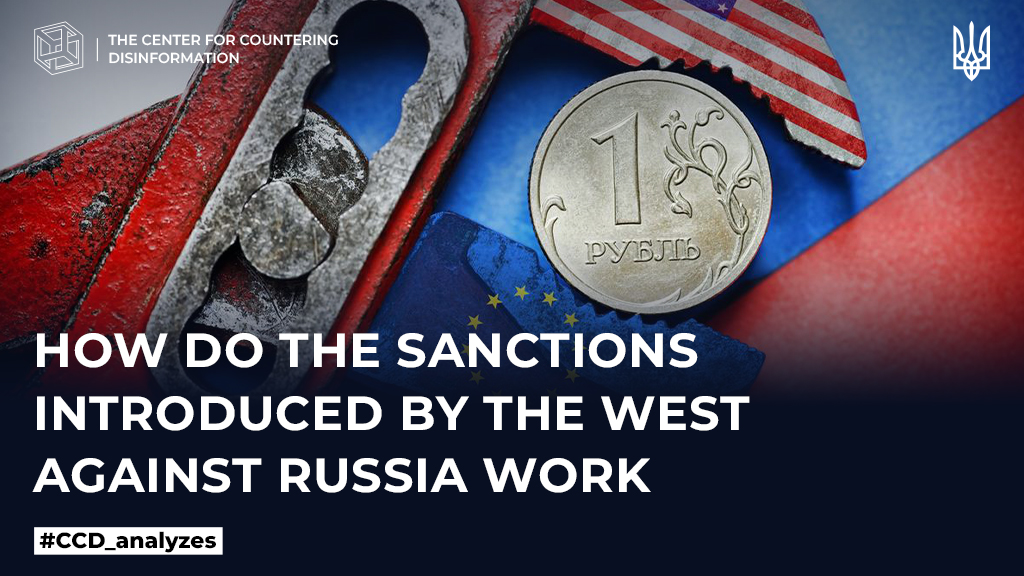In response to russia’s unprecedented and unprovoked military attack on Ukraine, the West imposed a comprehensive and powerful package of restrictive sanctions aimed at undermining the kremlin’s ability to finance the war. According to the Castellum global sanctions tracker dashboard, more than 9,100 restrictions have been imposed on the russian federation since the end of February 2022, and a total of 11,800 since 2014, when the russian federation occupied Crimea and part of the territory in the East. Now russia is the most sanctioned country in the world, ahead of Iran, Syria and North Korea.
Let’s consider the essence and effectiveness of these sanctions.
☝️ Sanctions against individuals and legal entities of the russian federation (travel ban, financing and freezing of assets) have been applied to 1,473 individuals and 205 legal entities from among leading political figures, oligarchs, military personnel and propagandists.
☝️ Sanctions related to the financial system have closed russia’s access to EU capital markets, which is gradually destroying the russian banking system. These include a ban on lending to russian banks and the freezing of their assets, a ban on the russian elite keeping large deposits in EU banks, exclusion from the SWIFT system, a ban on investments in projects co-financed by the russian direct investment fund, etc. Currently, up to 70% of the assets of the russian banking system are under sanctions, the losses of the 10 largest banks of the russian federation for the past year reached more than 3 billion dollars.
☝️ Sanctions in the energy sector include the establishment of a price ceiling for russian oil, a ban on the import of crude oil (delivered by sea) and coal, the export of oil refining technologies and equipment, etc.
Sanction pressure in the energy sector as a key donor to the russian budget led to a budget deficit of $34 billion in January-February 2023 (compared to a surplus of $5.5 billion for the same period in 2022). Revenues from oil and gas exports fell by 46% compared to last year (only in January 2023, Gazprom’s revenues from fuel exports fell from $6.3 billion to $3.4 billion). The ban on coal imports represents a loss of revenues for the russian federation in the amount of 8 billion euros per year.
☝️ Sanctions in the transport sector provide for the closure of EU airspace for all aircraft owned, registered or controlled by the russian federation, a ban on their repair and maintenance.
As a result, the russian federation will not be able to maintain aviation at the level of international standards, because of the more than 800 aircraft of russian airlines, 75% are built in the EU, USA and Canada.
In addition, the sanctions prohibit the entry of russian-flagged sea vessels to EU ports and the activities of russian and belarusian road freight transport operators in the EU.
☝️ Sanctions in trade deprived the russian federation of the main advantages provided by membership in the WTO, and prohibited the import to the EU of finished products made of steel, cement, wood, the export from the EU of computers, semiconductors, jet fuel and fuel additives that can be used by the russian army .
The total estimated value of export restrictions on goods and technologies for the russian federation reaches 32.5 billion euros (36% of EU exports before the invasion), imports – 89.9 billion euros (57% of pre-war imports).
❗️According to analysts’ estimates, the total losses of the russian federation due to external sanctions exceeded 500 billion dollars, of which at least 300 billion are frozen currency reserves of the russian federation. The outflow of capital from the russian federation abroad increased by 143 billion dollars last year. Losses from unreceived imports of goods and services from “unfriendly countries” are estimated at at least 50 billion dollars. According to IMF estimates, the russian economy will shrink by at least 7% in the medium term.
Losses due to sanctions have reached $3,500 per russian and are growing rapidly. In addition, every citizen of the russian federation has already directly or indirectly paid at least 50,000 rubles (almost $700) for the war unleashed by putin.
Consumer inflation is gaining momentum in the country, 26.3% of russians admitted that they no longer have the opportunity, as before, to save money for a “dark day”, 34.5% of citizens reported a complete lack of a financial security cushion. According to independent polls, more and more russians are thinking about the real reasons for their impoverishment and less and less blaming the “insidious West” for this.
russian oligarchs also felt the full effect of the sanctions. Due to the blocking and seizure of funds and property abroad and the termination of contracts with international partners, the 20 richest people in the russian federation lost at least 95 billion dollars last year, which makes them think about the feasibility of further supporting putin’s policies.
❗️❗️Despite putin’s assurances that international sanctions only made russia’s economy stronger, the facts indicate the opposite. Targeted EU sanctions in response to aggression in Ukraine hit the weak points of the russian economy, have the strongest impact on the well-being of russians, thereby significantly limiting the kremlin’s ability to achieve the criminal goals of the “special operation”.










